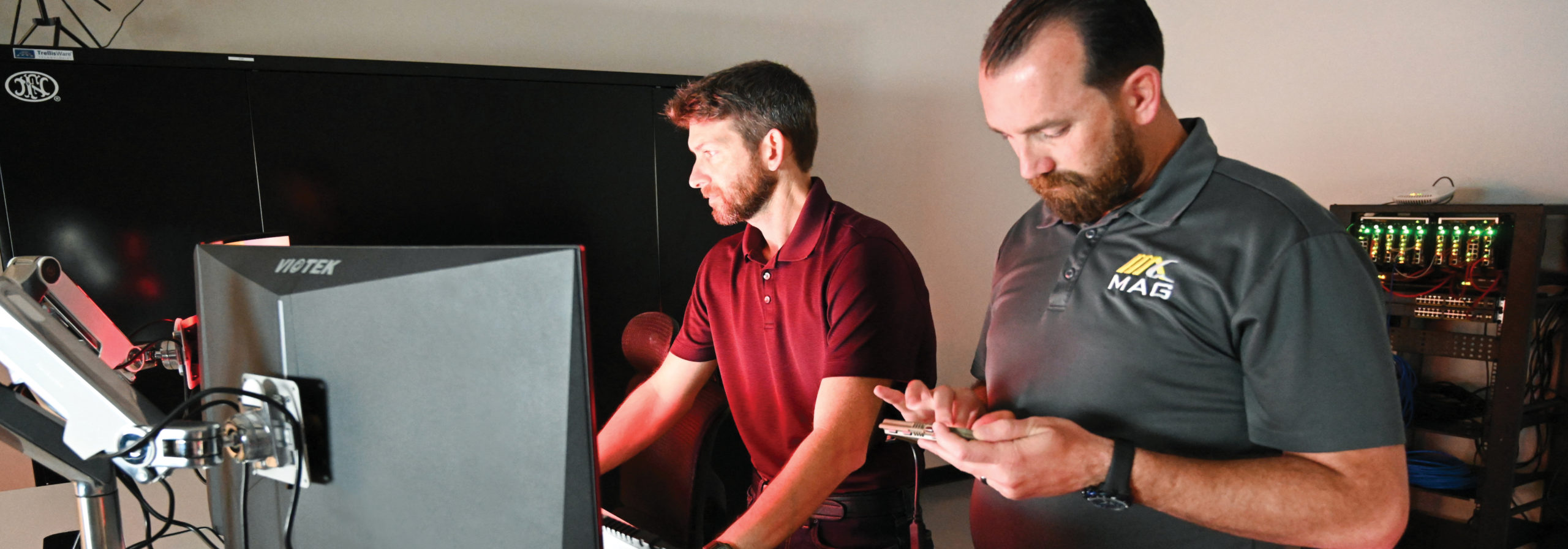Every year, MAG designs, tests, and implements multiple C5ISR validation or evaluation events, including SATCOM, for combat readiness. Satellite communication (SATCOM) support for JADC2, and our military and defense on the whole, is invaluable. Over the past decade, MAG has partnered with the DoD, providing military SATCOM solutions. There are explicit advantages to satellite communications – and the engineering capabilities that MAG provides.
Advantages Of SATCOM
Satellite communication has several benefits compared to terrestrial communications. First, it has greater connectivity and capacity than Earth-based systems. Geographical coverage is greater, especially in sparsely-populated areas; it essentially makes every region of the Earth accessible. In addition, it makes point to multi-point communication possible.
SATCOM also offers round-the-clock communication, increased broadcasting capabilities, and bandwidth, and it has numerous applications, including intelligence gathering and navigation support for ships and aircraft. Satellites’ ability to send and receive communications does not depend on the distance between points.
On the other hand, designing and launching satellites can be expensive and extensive, and they must be regularly maintained as satellite components can decrease in efficacy over time. In addition, securing communications must be a top-of-mind priority as satellites are an ever-increasing target for cyber attacks.

Securing Military SATCOM
According to U.S. Space Force General David Thompson, cyber attacks are happening “every single day,” and The Department of Defense (DoD) has called them the most worrisome threat to satellites.
Cryptographic resiliency and redundancy are critical to protecting military satellite communications in multi-domain environments. Millions and millions of dollars have already been invested into low-earth-orbit (LEO) satellites that can be rapidly deployed. This investment must be protected with the strongest data protection possible that not only protects the security of communications but the quality as well.
Key Facts:
- Cyber attacks cost six trillion dollars last year (2022).
- 30,000 pieces of malware are created every day.
- From 2015-2021, the DoD experienced over 12,000 cyber attacks.
- The U.S. Space Force is increasing investment in cybersecurity defenses, talent, and standards.
- Government support via Space Policy Directive-5 (SPD-5) and NIST both outline cybersecurity precautions for the commercial-space ecosystem.
The DoD Recognizes The Need For Partnering With Private Businesses In Order To Meet Next-Gen Security Threats:
“Small businesses are key to DOD’s mission and innovation initiatives…Their agility delivers the speed and performance to transform the defense industrial base and provide competitive advantage. And this agility drives…value faster by increasing innovation, responsiveness, customer satisfaction, productivity and quality.” (Amy Murray, Director, Office of Small Business Programs, DoD)
Cultivating strong relationships with innovative companies that can engineer critical technologies in support of our nation’s defense and combat similar investments by Russia and China is an essential strategic tactic that must be continually prioritized by military and intelligence agencies.
DoD SATCOM Priorities
Early this year, the Department of Defense released its modernization plans for its SATCOM system, recognizing the imperative of upgrading the security and resiliency of its communication capabilities. The Enterprise Satellite Communications Management and Control Implementation Plan focuses on the DoD’s Digital Modernization Strategy and the U.S. Space Force’s Vision for Satellite Communications.
Part of this plan includes providing “the foundational capabilities necessary for the on-going Future SATCOM Force Design, including increased reliance on commercial SATCOM and stronger partnerships with our Allies, as the Department builds out and executes Joint All Domain Command and Control (JADC2).
The plan also affirms past priorities of modernizing command, control, communications, computer systems, and infrastructure. In addition, the DoD and Space Force want to implement the vision of a seamless network of military and commercial comsats in all orbits, accessible to troops, vehicles, ships and aircraft via ground terminals and mobile receivers that would automatically “hop” from one satellite network to another to avoid jamming.
The strategy intends to “increase the flexibility, agility and resiliency of DoD SATCOM.” This is a purpose and plan that MAG fully supports and maintains the capabilities to assist in its development and implementation.
How MAG Empowers Military SATCOM
The SATCOM Lab At Our Maryland Interoperability Innovation Center
MAG’s Maryland Interoperability Innovation Center provides software engineering, modeling and simulation, and hardware design for diverse communications.
At this location we provide rapid acquisition, development, integration, and test support services that enable us to meet aggressive development and low-rate production schedules.
The Maryland Innovation Center houses a SATCOM Lab that focuses on satellite terminal development, interoperability, integration, testing, and repair.
It Has Three Major Elements:
- A Radio Frequency Lab
- A Mobile Lab Outfitted For Airborne Satellite Terminal Development, Integration, And Functional & Performance Certification Testing
- CONUS Satellite Network To Support Advanced Testing
It also provides a full suite of Ku-band, L-band, and modem test equipment. We have test fixtures and troubleshooting tools that support the repair of commercial antenna and modem products, and the innovation center also contains an environmental chamber instrumented for Ku-band and L-band devices. This chamber is primarily used for environmental screening/testing of modems and antenna RF components using cold and heat cycles.
Other On-Site Features Include:
- Satellite network infrastructure (hub, routers, switches, VPN devices, etc.) to support satellite terminal development, integration, testing, and repair.
- A customized vehicle outfitted with racks, LRU mounting trays, wiring, cabling, power systems, test equipment, and airborne satellite terminal equipment focused on creating a “real-world” mobile test environment. The mobile lab enables
- Over-The-Air (OTA) satellite testing in conjunction with the CONUS satellite network.
The mobile lab also serves as a final quality assurance (QA) step for equipment prior to our integration on our customer’s platforms.
The CONUS satellite network consists of a MAG-owned Evolution Hub hosted at a commercial teleport. The teleport connects the Evolution Hub on the IF side to IF/RF converters, RF receivers/transmitters, and an 11-meter satellite antenna pointed at Intelsat’s G-16 satellite (other satellite options are available).
The teleport connects the Hub on the baseband side to the public internet (private fiber options are available). The network is remotely managed by MAG. The satellite network routinely supports mobile lab testing and has also been used for flight test support.

As we said, we’ve worked for over 10 years with the DoD formulating, integrating, and supporting satellite communications systems. In particular, we currently operate the Joint Management and Operations Subsystem (JMOS). This is a completely software-based tool that manages internet protocol (IP)-based communications over Worldwide Global SATCOM (WGS).
We Provide:
- Systems Engineering
- Information Assurance
- Testing & Integration
- Acquisition
- Logistics
- Configuration Management
- Software Support
Projects We Have Worked On Include:
- Modernization of Enterprise Terminals (MET)
- Enhanced Bandwidth Efficient Modem (EBEM)
- Teleport
- Standardized Tactical Entry Point (STEP)
- Regional Hub Node (RHN)
- Joint Management & Operations System (JMOS)
- Replacement Remote Frequency Indicator Selector (RRFIS)
- Replacement Frequency Modulation Order Wire (RFMOW)
- Control Monitor & Alarm (CMA)
- Integrated Satellite-GIG Operations Management (ISOM)
- Other Critical Initiatives In The Wideband Community.
IP Over SATCOM Capabilities for the Military
MAG possesses unique expertise in developing solutions for transporting IP-based services over SATCOM networks.
We have in-depth knowledge of the waveforms, modem systems, and management/control interfaces of both commercial and military FDMA and MF-TDMA systems. We also have experience optimizing the transport of converged services in constrained-bandwidth environments.
Our clients can trust MAG to help them engineer and operate cost-effective and reliable IP SATCOM networks. Connect with us today for more information about all our JADC2 capabilities.




